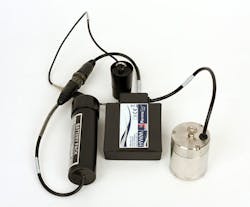Addressing the Water Leakage Challenge in Copenhagen
Three quarters of the pipes in Copenhagen are more than 60 years old and 10% date back over a century. Yet the Danish capital serves as an example that very old pipe network, if maintained and managed, can still perform well - water loss in the city is 7%. This article examines the partnerships and technology that have enabled such a low level of water loss to be achieved.
By Simon Fisher
Denmark introduced a water supply tax in 1994 to encourage water companies to reduce leakage. If more than 10% of total water supplied is lost to leakage, water utilities are charged €1 for every cubic metre lost beyond the 10% threshold. The water supply tax alone is sufficient incentive for water companies to reduce leakage as much as possible.
With more than one million water customers in the Greater Copenhagen area, HOFOR is Denmark’s largest utility company. Working with Danish leak detection specialist Leif Koch and its British partner HWM, HOFOR traditionally searched for leaks using a lift-and-shift method: approximately 40 Permalog+ data loggers were deployed for 48 hours and then moved to a new location. In 2009 HOFOR began to concentrate on reducing water leakage through area studies, creating permanent installations of data loggers in Copenhagen.
In a pilot project, HOFOR installed 185 data loggers in Copenhagen on a permanent basis over a five-year period. The permanent installation enabled the company to quickly find out when and where a leak had occurred.
On the second day of the project, the detection team identified a leak. Instead of tackling it, they decided to leave it and see how many days would elapse before the water reached the surface. After 10 days in which nothing happened, the team dug down to the leak and discovered that water was running directly into the sewer.
“If we had conducted a study of this particular area using our old method a week before the leak began it would have been three years before we returned to this area and discovered the leak,” explains Kim Roar, team leader at HOFOR. “In other words, the leak would have been continuously running into the sewer for three years. By our rough calculations, this leak alone would have cost us 1.2m krone (£116,000).”
In 2012 and 2013 HOFOR typically found 600-700 leaks a year, but by 2014 this figure had come down to 425.
Live information
“In 2009, we had the idea of connecting the loggers to the internet,” explains Jørgen W. Koch, owner and CEO of Leif Koch.
“Working with HOFOR and HWM, we developed ALMOS LEAK (Acoustic Leak Monitoring Online System). This system uses Google Maps technology to allow users anywhere in the world to access their live leak information by visiting our dedicated website.”
Users log into the website to see the exact location, condition and noise levels of all their installations. This information can be presented either as a list or shown on a map of the area.
In the map view, loggers in a ‘normal’ state appear as blue dots, those with a leak as red ones, and those with unusual readings display a yellow warning sign. Clicking on one of the dots gives more detailed information about the logger, including its serial number, noise level, signal strength and acoustic spread. Users can instantly identify problem areas and then carry out an in-depth analysis of the leak situation. In the map view, loggers can be sorted according to a number of variables, and historical leak data for each logger is available at the click of a mouse.
Previously, it would have taken several months to examine water networks in a particular area; with loggers permanently connected to ALMOS LEAK, examinations take place every night. Engineers can localise and repair leaks straight away, preventing large amounts of water being lost and avoiding damage to pavements and road surfaces.
Spider logger
Since it relies on a receiver situated above ground, detecting leaks with the Permalog+ can run into problems with local owners or residents: they might object to the receiver on aesthetic grounds; they might demand payment before accepting a receiver on their property or they might even vandalise or steal the receiver.
With these issues in mind, in 2012 HOFOR asked Leif Koch to develop a data logger that could be located completely underground. HWM worked with Leif Koch to produce what became known as the Spider Logger. Designed to meet Denmark’s particular requirements, the Spider Logger is essentially a Permalog+ but more suited to the restricted dimensions of the country’s shallow access chambers.
The new logger separates the PCB and sensor from the battery, with the sensor placed on top of the valve, the electronics down one side of the chamber and the battery down the other. This proved the only way that all the necessary components could be placed inside the chamber.
Benefits of early detection
Experience has taught HOFOR the added advantage of early leak detection. If a leak is allowed to go undetected for a long period of time, water utilities are liable for the potentially extensive damage caused by the leak, as well as the cost of the lost water.
“If you repair a leak a few days after it happens, it’ll cost around £2,000,” comments Roar. “But if you wait a lot longer you could end up paying 100 times as much.”
Westy Rasmussen, senior consultant at Leif Koch agrees: “This is all about finding the leakage as cheaply as possible. And it means engineers are not called out in the middle of the night to fix a huge leak that has suddenly appeared. They can repair it in the daytime, and when it’s much smaller and more manageable.”
Simon Fisher is technical director at HWM.
More Water & WasteWater International Archives Issue Articles


